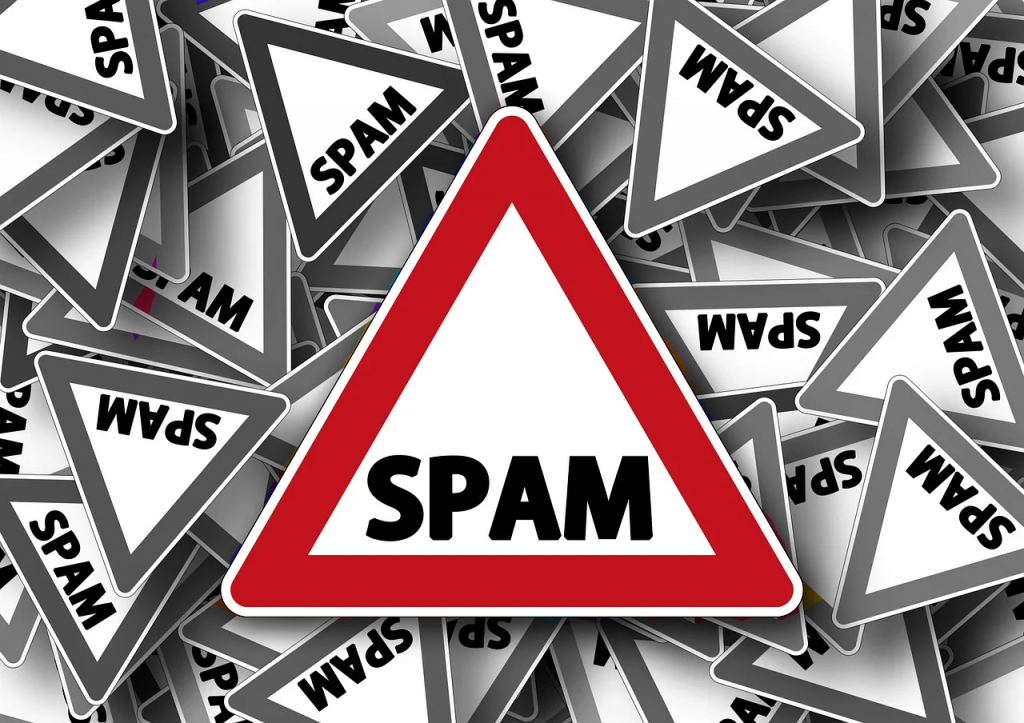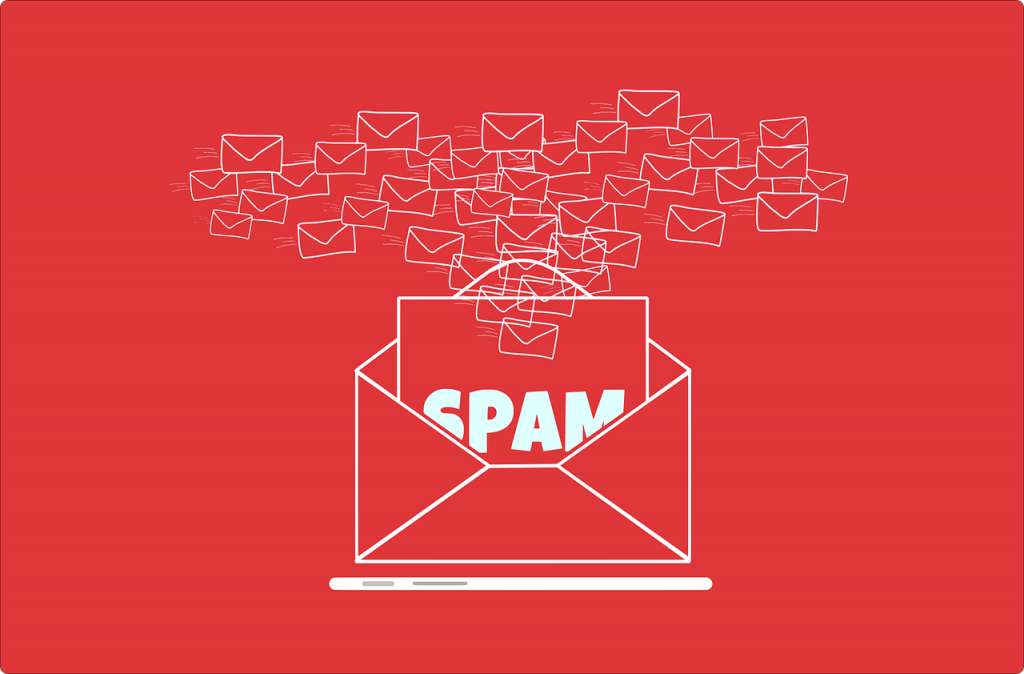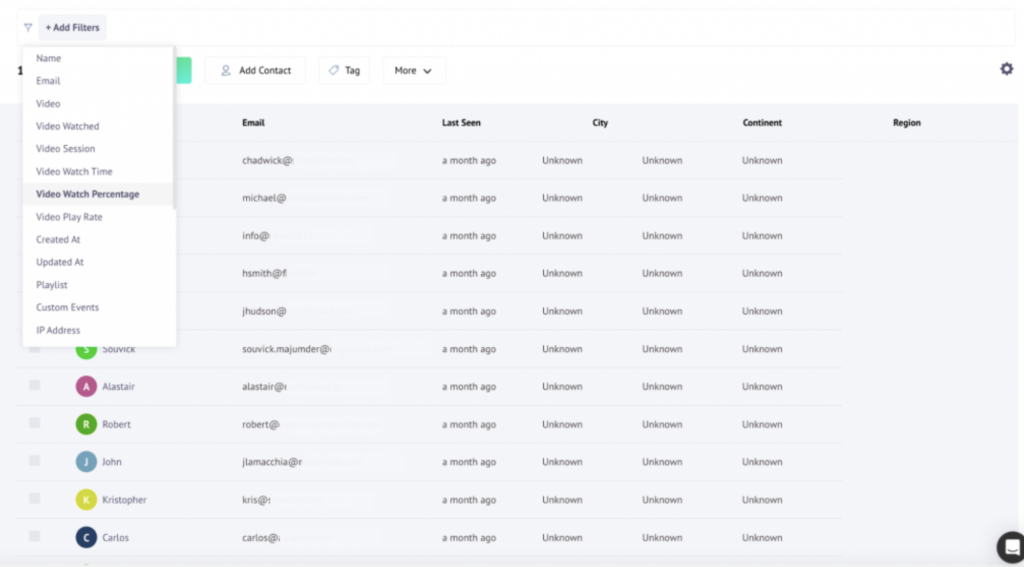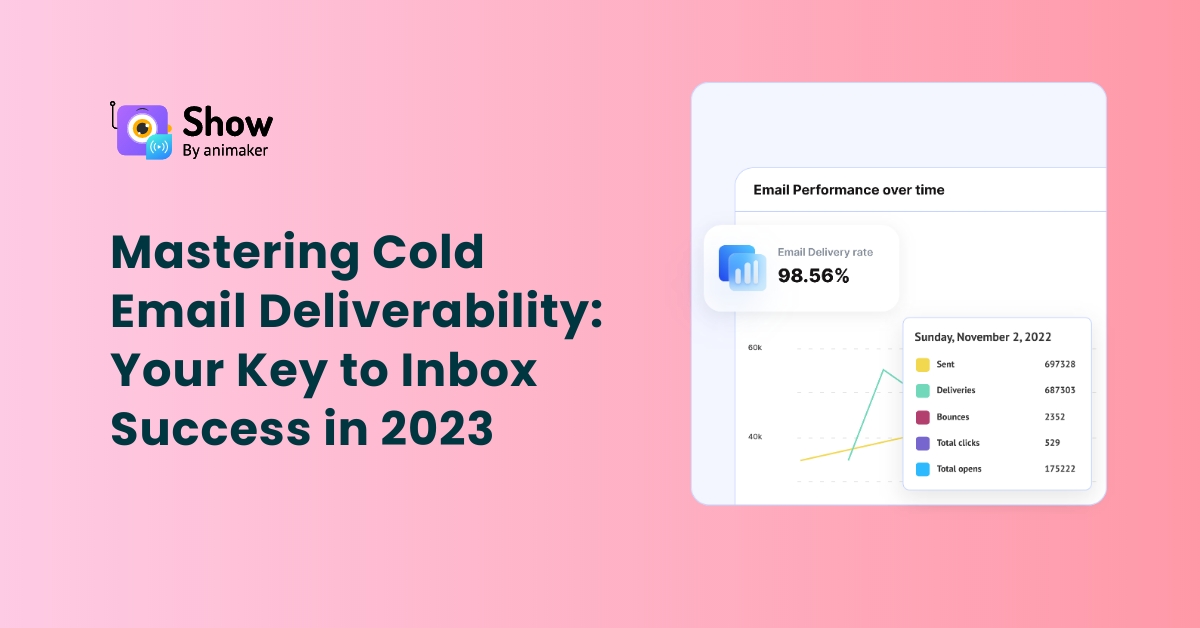Contents
Reasons Why Cold Emails Get Blocked
14 Deliverability Checks to Ensure Emails
Improving Cold Email Deliverability with Show: Unveiling the Path to Success
Mastering Cold Email Deliverability: Your Key to Inbox Success in 2023
Cold emails are only worthwhile if they get delivered to the intended inboxes. Cold emails stand as an essential tool for businesses to establish connections, foster relationships, and drive growth. However, even the most well-crafted cold emails can fall victim to failed email deliverability. As it is, the average open rate of cold emails is just 44%. Hence, it is important for your cold emails to achieve the highest possible email deliverability rates.
Crafting compelling cold emails has evolved into a cornerstone of modern business strategies. However, amidst the vast ocean of digital correspondence, ensure that your cold emails land in the recipient's inbox. This article explores cold email deliverability. It looks at the barriers that can hinder their journey and provides a comprehensive roadmap to guarantee that your cold emails have the highest email deliverability.
What Are Cold Emails?
Cold emails are unsolicited messages sent to recipients who have no prior engagement or relationship with the sender. These emails are often used by businesses to initiate contact, share information, or promote products and services. While they can be a powerful tool for generating leads and expanding a business's outreach, they can also face significant hurdles on their journey to the recipient's inbox.
Reasons Why Cold Emails Get Blocked
In this section, we delve into the key reasons why cold emails often get blocked.
1. Outdated SPF, DKIM, and DMARC Records
The foundation of email deliverability lies in proper authentication mechanisms, namely SPF, DKIM, and DMARC. These records establish your email's legitimacy, ensuring that it does not fall victim to spam filters. Failing to update these records can lead to your cold emails being flagged as suspicious or even blocked. To overcome this, regularly review and update your SPF, DKIM, and DMARC configurations to align with the latest industry standards.
2. Email Blast Mistakes: CC and BCC Spam
Sending cold emails en masse using the CC (Carbon Copy) or BCC (Blind Carbon Copy) fields is a red flag for spam filters. This approach not only compromises recipient privacy but also triggers suspicion among email service providers. To improve your cold email's deliverability, avoid CC and BCC altogether. Instead, use personalized email tools that can effectively manage bulk communications without compromising authenticity.
3. The Spam Marker Effect
When multiple recipients mark your cold email as spam, it sends negative feedback to email providers. Consequently, your sender's reputation plummets, leading to blocked emails. To mitigate this risk, ensure your cold emails are tailored, relevant, and engaging. Crafting compelling subject lines and content reduces the likelihood of recipients flagging your emails as spam.
4. Unverified Email Lists
Cold emails sent to unverified email lists are more likely to bounce or be reported as spam. Acquiring and using verified, targeted email lists ensures you are reaching legitimate recipients who are genuinely interested in your content. This strategy not only boosts deliverability but also improves engagement rates, leading to a healthier sender reputation.
5. Breaching Daily Email Quotas
Exceeding the daily sending limits set by your email service provider can raise red flags, causing your cold emails to be blocked. To sidestep this issue, be aware of your email provider's sending limits and adhere to them strictly. If your campaign requires sending a higher volume of emails, consider spreading them out over time to avoid tripping spam filters.
6. Avoid Spam-Triggering Words
Certain words and phrases can trigger spam filters, causing your cold emails to be blocked or relegated to the spam folder. Avoid using aggressive marketing language, excessive capitalization, or excessive exclamation marks. In fact, around 45% of emails end up being classified as spam. Crafting thoughtful, professional content enhances the chances of your emails bypassing these filters.

7. The Importance of Choosing the Right Email Service Provider
The email service provider (ESP) you choose can significantly impact your cold email deliverability. Opt for a reputable ESP that offers robust deliverability tools, spam monitoring, and authentication features. A reliable ESP ensures your emails are routed through trusted channels, boosting the chances of cold email deliverability.

14 Deliverability Checks to Ensure Emails
Enhance your cold email deliverability with the highest chances of reaching their intended recipients' inboxes with the 14 deliverability checks to ensure the highest email deliverability.
- Set Up a Separate Email Account for Outbound
In the dynamic landscape of cold emails and email deliverability, segmentation is your ally. Establishing a distinct email account solely dedicated to outbound campaigns can insulate your primary email from potential pitfalls. By implementing this separation, you ensure that any deliverability concerns associated with your cold emails will not impact your primary email address’ reputation.
- Warm Up New Email Accounts
In the realm of cold email deliverability, nurturing new email accounts is akin to cultivating a garden. Just as plants need time to flourish, new email accounts require a gradual approach. Gradually increase your outbound email volume to build a positive sender reputation. This warming-up process decreases the chances of your emails being tagged as spam, ensuring a smoother journey to the recipient's inboxes.
- Verify the Reputation of Your Domain and IP
Before embarking on your cold email journey, it is imperative to assess the standing of your domain and IP reputation. Utilize online tools to scrutinize for potential blacklistings or negative associations that could jeopardize your email deliverability. By preemptively addressing these concerns, you enhance the likelihood of your cold emails reaching their intended recipients.
You can check the reputation of your IPs at Talos Intelligence Center.
- Set Your SPF & DKIM
In the intricate tapestry of email deliverability, SPF (Sender Policy Framework) and DKIM (DomainKeys Identified Mail) serve as the bedrock of authenticity. Configuring these authentication mechanisms correctly bolsters your credibility and elevates the chances of your cold emails bypassing spam filters. Through proper implementation, you establish trust and ensure that your messages resonate as genuine communications.
- Check Your Email Provider Limits
Navigating the realm of cold email campaigns requires a keen awareness of your email provider's limits. Adhering to these thresholds is pivotal, as exceeding them can trigger alarms not only within your email service provider but also within recipients' email platforms. By staying within these boundaries, you foster a smoother, unhindered path for your cold emails, increasing the likelihood of reaching the inbox.
- Check for Spam Words
In the delicate art of crafting cold emails, linguistic precision is paramount. Detecting and eliminating potential spam-triggering words is a proactive measure to enhance your email deliverability. Scrutinize your content for terms that could raise red flags in spam filters. By fine-tuning your language, you not only increase the chances of your cold emails avoiding spam folders but also present a professional and genuine tone to recipients.

- Add Personalization
Personalization is the golden key that unlocks engagement in the world of cold emails and email deliverability. Incorporate recipient names and relevant details to elevate your emails from generic messages to tailored communications. In fact, personalization in subject lines increases the chances of emails getting opened by 26%. This not only fosters a deeper connection but also diminishes the likelihood of your emails being flagged as spam. The extra effort invested in personalization goes a long way in establishing rapport and trust.
- Do Not Track Unnecessary Links and Opens
In the realm of email deliverability, every action counts. While tracking links and opens can provide insightful metrics, excessive tracking can trigger spam filters. Only utilize tracking features if they align with your campaign goals. By adopting a measured approach to tracking, you maintain a clean sender reputation and enhance the odds of your cold emails reaching their intended recipients.
- Keep the Form of the Email as Simple as Possible
Simplicity reigns supreme in the world of cold email deliverability. While elaborate designs may visually impress, they can inadvertently raise spam suspicions. Opt for a clean, straightforward email format that maintains the focus on your message's content. By adhering to simplicity, you eliminate unnecessary distractions and present a professional, trustworthy appearance to recipients.

- Polish Your HTML Signature
Within the world of cold email deliverability, attention to detail extends to every aspect of your message, including your HTML signature. A polished signature not only adds a touch of professionalism but also contributes to your overall sender reputation. Crafting a well-designed HTML signature reflects your commitment to quality and authenticity, fostering a favorable perception among recipients.
- Upload Contacts in Batches
Navigating the seas of email deliverability requires a strategic approach, even when uploading your contact list. Dividing your list into manageable batches is a proactive move that prevents sudden volume spikes, which can trigger alarms for both your email service provider and recipient platforms. By methodically uploading contacts, you minimize the risk of flagged emails and ensure a smoother journey to the inbox.
- Care About the Quality of Contacts
In the realm of cold email campaigns, quality surpasses quantity. A meticulously maintained and updated contact list is the bedrock of successful cold emails and email deliverability. Regularly review and refine your list to minimize bounce rates and ensure you are engaging with genuine, interested recipients. This commitment to quality not only enhances your sender reputation but also maximizes the impact of your campaigns.
- Send Only to Business Addresses of Individuals
Laser-focused targeting is the hallmark of successful cold email campaigns. Concentrate your efforts on sending emails exclusively to business addresses, as this enhances your email deliverability significantly. By avoiding personal addresses and honing in on professional contexts, you minimize the chances of being flagged as spam and increase the likelihood of meaningful interactions.
- Monitor Deliverability and Track Key Metrics
In the dynamic realm of email deliverability, vigilance is key. Regularly monitoring crucial metrics, such as email delivery rates, open rates, click-through rates, and bounce rates, empowers you with insights into the performance of your cold email campaigns. These metrics serve as guides, enabling you to identify trends, rectify issues, and adapt strategies for optimal success.

Improving Cold Email Deliverability with Show: Unveiling the Path to Success
In the fast-paced landscape of modern business communication, the art of crafting effective cold emails is both a science and an art. However, a well-crafted cold email is only as valuable as its ability to reach its intended recipient's inbox. This is where Show steps in, revolutionizing the world of cold email deliverability with a suite of powerful features designed to elevate your campaigns from mere messages to impactful interactions. Let's explore how Show empowers you to achieve the highest email deliverability and reap the rewards of enhanced engagement and growth.
1. Highest Email Deliverability - Pre-warmed-Up IPs
Imagine a world where your cold emails consistently reach their intended recipients, unobstructed by spam filters or deliverability concerns. With Show, this is not a mere fantasy but a reality. Our platform utilizes pre-warmed-up IPs, a game-changing feature that guarantees the highest email deliverability rate in the industry. These IPs have been primed and nurtured, ensuring that your cold emails not only survive the journey but thrive in the recipient's inbox.

2. DKIM and SPF - Fortifying Security Compliances
In the realm of cold email deliverability, security compliance is non-negotiable. Show takes this responsibility seriously by seamlessly navigating the intricacies of DomainKeys Identified Mail (DKIM) and Sender Policy Framework (SPF) authentication. Your emails pass through these stringent security measures with finesse, cementing your reputation as a trusted sender in the eyes of both email providers and recipients.
3. Advanced Email Analytics - Monitor and Enhance Deliverability
The path to cold email mastery demands insight, and Show's advanced email analytics provide just that. With our platform, you have the tools to meticulously monitor your open rates and deliverability rates. This real-time tracking empowers you to gauge the effectiveness of your campaigns, make informed adjustments, and ensure that your cold emails are not just being delivered, but are also being opened and engaged with.

4. Enables Personalization - In-Built CRM for Enhanced Engagement
Personalization is the cornerstone of effective cold emails, and Show's in-built Customer Relationship Management (CRM) system takes personalization to new heights. By harnessing this powerful tool, you can tailor your messages to individual recipients, improving engagement and significantly boosting your cold email deliverability. When your emails resonate on a personal level, they are less likely to be flagged as spam and more likely to foster genuine connections.

Conclusion: Achieving Cold Email Deliverability Excellence
Remember that success in cold email deliverability is not a destination. It is a continuous journey of adaptation and refinement. By mastering cold email deliverability, Embrace the power of deliverability, harness the capabilities of Show, and embark on a trajectory where your cold emails hit the mark all the time.
Frequently Asked Questions (FAQs)
Frequently Asked Questions (FAQs) on Cold Email Deliverability
1. Why is cold email deliverability important for my business?
Cold email deliverability is crucial because it determines whether your carefully crafted emails actually reach your intended recipients' inboxes. Without high email deliverability, your messages might get flagged as spam, bounced, or even blocked, rendering your outreach efforts ineffective. Ensuring the highest email deliverability rate enhances your chances of making meaningful connections, fostering relationships, and driving growth for your business in the competitive digital landscape.
2. How can outdated SPF, DKIM, and DMARC records affect my cold email deliverability?
Authentication mechanisms like SPF, DKIM, and DMARC play a pivotal role in email deliverability. These records establish your email's legitimacy and prevent it from being marked as spam. Outdated or improperly configured records can raise red flags for spam filters, leading to your emails being blocked or relegated to the spam folder. Regularly updating and maintaining these records is essential to maintaining a positive sender reputation and ensuring your cold emails reach their intended recipients.
3. Can a dedicated email account for outbound campaigns
improve cold email deliverability?
Yes, using a separate email account solely dedicated to outbound campaigns can significantly enhance your cold email deliverability. This approach insulates your primary email address from potential deliverability issues. This strategic separation ensures that any deliverability concerns associated with your cold emails will not tarnish your primary email's credibility.



